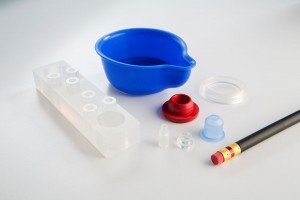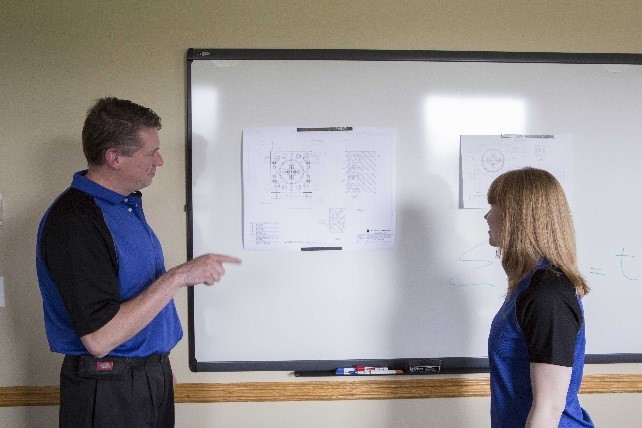Fundamentally, a setup charge is what gives us the ability to make our customers unique parts. A setup charge is a non-recurring fee that is charged to the customer to cover the costs associated with creating a new, custom part or non-standard O-Ring. Several stages of design and manufacturing are required to create molded rubber parts.
To help you understand what goes into each of these molded part setup charges, we broke them down by type.
Molded part setup charges, explained.
Mold layout and design: Engineers at Apple Rubber will review a part and design a mold to efficiently meet a customer’s cost, delivery and quality requirements. Solidworks CAD software is utilized to create solid models of mold components in a virtual environment. These solid model files are then sent to our in-house mold shop, where designs on the computer screen are turned into actual mold plates.
Mold components: Basic rubber molds are made up of between 10 and 100 individual components including mold plates, alignment pins and bushings and hinges. More complex molds, such as valve gated cold runner molds or flashless inserted transfer molds, can have thousands of components.
Some molds require additional accessories to make them more efficient and operator friendly. These accessories can include loading boards, knockout boards, trim dies and other associated fixturing. Mold accessories are included in the setup charge as they are an integral part of the manufacturing process.
Mold steel: Different types of mold steel are used to manufacture molds. Simple prototype molds are made of a free machining steel which allows for their quick turnaround. Production molds are made from either pre-hardened mold steel or annealed steel, then hardened. Production mold steel is harder and more costly, but exhibits far less wear during longer manufacturing runs.
Machining: Mold plates and components are machined using either conventional or EDM techniques. Apple Rubber’s in-house mold shop has the capability to produce most molds within our manufacturing facility.
Finishing: Some mold components require a particular surface finish. The as-machined component must be polished or media blasted to meet the customer requirements.
Assembly: All components must be fitted and assembled to create an operational mold. Many components require precision fits that must be maintained to ensure proper mold function.
Setup: Every new mold must be installed in a press. Then, appropriate process parameters must be determined for this particular mold, press and material combination. Basic settings include platen temperature, clamp force, cure time and amount of rubber material.
Storage and maintenance: Every rubber mold must be maintained to ensure it produces quality parts over time. We maintain our inventory of over 5,000 molds through a preventive maintenance module within our centralized manufacturing package. Maintenance work orders are automatically generated and records are retained. Based on either time or number of cycles, every mold is cleaned and reviewed for critical characteristics like alignment (registration), wear surfaces and cavity cleanliness.
Inactivity: Molds that have not been used for a period of seven years will be considered abandoned and will be disposed of. Mold components will be made unusable and recycled as scrap metal. This disposal procedure is permanent. Should parts be required from a discarded mold, the customer will be required to pay a new setup charge with an associated lead time.
Exclusivity: The customer paying the setup charge has exclusive rights to the parts produced from the mold associated with that setup charge. No other customer has access to that mold without the written consent of the customer who paid the setup charge.
Identification: Customers may request that specific identifying features be added to a mold or die during its manufacture. Identifying features may include the customer name or part number or a specific customer supplied identification tag. Requests to add identifying features after the mold has been made will be reviewed and may carry an additional cost.
Destruction: The customer that paid the setup charge may request that a mold be destroyed. Mold destruction can take place by different means, generally the mold is cut in two. The destroyed pieces will be recycled and cannot be released to the customer. Digital photographs of the destroyed pieces can be sent to the customer upon request.
Secrecy: Apple Rubber creates rubber parts through the use of proprietary techniques. Molds, designs, drawings, solid models and machining procedures are proprietary, and as such cannot be shared or sold.
Approval: Setups are approved based on the parts they produce, not mold geometry. The combination of a specific mold and comprehensive process are required to produce a given part. A perfect mold will not produce accurate parts without particular process parameters. Setups are a specific combination including a mold and a process.
Dissolution: Apple Rubber has been around since 1971, and has exhibited extraordinary stability and steady growth. In the unlikely event of Apple’s voluntary or involuntary bankruptcy the associated tooling will be shipped to a customer, at their expense, if they so desire.
Let’s talk molded parts.
In the market for molded parts? We’re here to help. For more information, connect with us on Twitter or LinkedIn or contact our engineering team for assistance.


